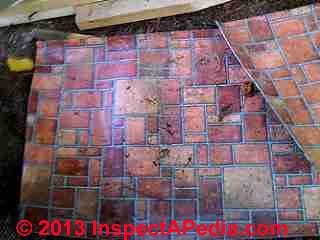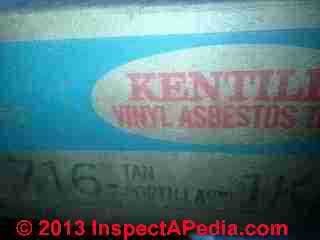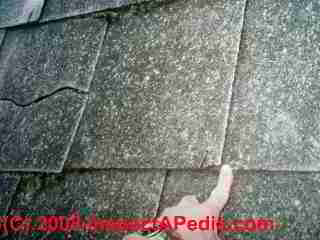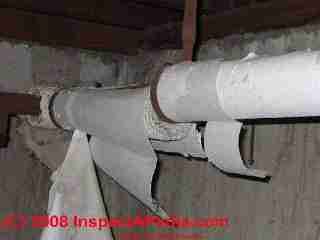 Asbestos Building Material Disposal Procedures
Asbestos Building Material Disposal Procedures
Advice & regulation for the disposal of asbestos floor tile, roofing, insulation, or other materials
- POST a QUESTION or COMMENT about asbestos building material regulations, standards, & codes
Asbestos disposal advice, guidelines, & regulations:
This article describes the regulations for disposal of various types of asbestos-containing materials commonly found on or in buildings such as asbestos cement roofing & sididing, asbestos floor tiles, asbestos insulation found on heating pipes, boilers, furnaces, or plumbing, and cement asbestos sheet products.
For handling and disposal guidance concerning old roofing material, siding material, vinyl-asbestos floor tiles, asbestos pipe or boiler or furnace insulation, or other asbestos containing or suspect asbestos containing materials at a job-site, contact the US EPA, your state Department of Environmental Protection/Conservation, or your local building and health departments.
InspectAPedia tolerates no conflicts of interest. We have no relationship with advertisers, products, or services discussed at this website.
- Daniel Friedman, Publisher/Editor/Author - See WHO ARE WE?
How to Dispose of Asbestos Containing Materials: asbestos floor tiles, asbestos sheet flooring, asbestos insulation, asbestos roofing etc.
Disposal of Asbestos Containing Flooring, Roofing or Siding Materials
[Click to enlarge any image]
At OSHA ASBESTOS ROOF/SIDING REGULATIONS we discuss (briefly) the regulation of demolition & removal of cement asbestos or other asbestos containing roofing and siding materials.
At ASBESTOS ROOF MATERIALS we discuss environmental issues surrounding disposal of fiber cement roofing products that contain asbestos.
ASBESTOS REGULATIONS FOR ONTARIO [PDF] are published under the Occupational Health and Safety Act and are in Ontario Regulation 278/05 [PDF] also found at http://www.e-laws.gov.on.ca/html/regs/english/elaws_regs_050278_e.htm
How to Dispose of Vinyl-Asbestos or Asphalt Asbestos-Containing Floor Tiles
Although not defined strictly as "PACM", both OSHA standards also require asphalt and vinyl flooring material installed no later than 1980 be "considered" and "treated" as asbestos-containing, until the building owner proves the flooring is not ACM.
This includes not only the flooring material, but associated mastics and backings.
See ASBESTOS FLOORING IDENTIFICATION for details about vinyl-asbestos flooring including floor tiles and sheet flooring.
But this does not meant that asphatl asbestos floor tile, vinyl asbestos floor tile, or asbestos-conatining sheet flooring are necessarily hazardous nor friable materials.
The hazard from asbestos floor tiles or sheet flooring, as we explain below, depends on the condition of the flooring and what is going to be done to it.
Three Options for Disposal of Asbestos-Containing Floor Tiles
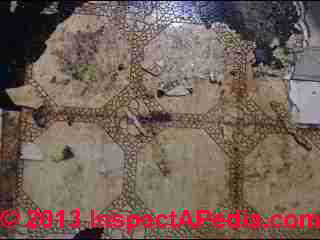 The following advice for disposal of vinyl-asbestos or asphalt asbestos floor tiles is adapted from the Minnesota State Department of Health:
The following advice for disposal of vinyl-asbestos or asphalt asbestos floor tiles is adapted from the Minnesota State Department of Health:
State health departments typically recommend that all asbestos debris and waste is disposed of in a landfill that accepts asbestos-containing waste. There are three methods of disposing of asbestos waste and they are:
- Contact local waste hauler for special pick-up.
- Contact licensed abatement contractor for pick-up and disposal.
- Dispose of waste yourself.
Watch out: if you are disposing of asbestos-containing waste yourself, you should contact your local state health department for detailed instructions.
For example, while a landfill may accept asbestos-containing-material (ACM) (as the material may be buried and thence non-hazardous, special requirements may apply to protect workers and buildings from asbestos dust during collection, bagging, removal, and transportation.
- Ref: MN DPH
US EPA Guidance on Disposal of Asbestos Floor Tiles
Reader Question: safe disposal of "new" old stock Kentile vinyl asbestos floor tiles
I recently bought some tile at a garage sale. It wasn’t until I was loading it and turned it over that I read the word asbestos. So now I have this tile. Is this tile safe to install? I’ve attached pics of the box and tile. It is Kentile Vinyl Asbestos Tile 12x12 sheets in Tan Portilla (716) color. The box also has 1K298C on it.
I just wanted to know if these should be disposed of or if they are safe. Thank you. - R.R. 9/6/2013
Reply: intact VAT is not normally friable - EPA guidance for disposal is here
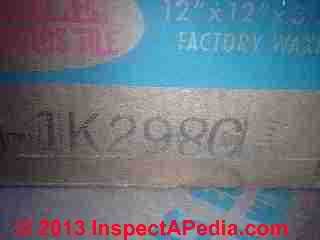 The bottom line, in my opinion, is that you can dispose of intact Kentile or other vinyl-asbestos floor tiles as ordinary construction debris.
The bottom line, in my opinion, is that you can dispose of intact Kentile or other vinyl-asbestos floor tiles as ordinary construction debris.
I base this view on a review of detailed US EPA guidance on asbestos-containing floor tile disposal. The EPA explains that the concern for asbestos hazards focuses on *friable* asbestos - intact vinyl asbestos floor tiles are not friable
, but old, installed flooring might *become* friable as a result of aging, exposure to environmental conditions, or damage during demolition of an existing, installed floor. It seems to me that such is *not* the case when you are disposing of "new" old stock vinyl asbestos flooring such as you described.
Below I quote from a letter from the US EPA to Richard A. Griffin, 11 June, 1987 in which the EPA explains this position. Quoting in excerpt form from a letter titled:
Re: Vinyl Asbestos Floor Tile Removal Prior to building Demolition.
EPA: Disposal of Intact Vinyl-Asbestos Floor Tiles
Vinyl Asbestos Floor Tile Removal Prior to building Demolition
Thank you for your May 1, 1987, letter to Charles Loomis of this office asking if vinyl asbestos floor tile should be removed prior to building demolition
Asbestos removal during building demolition is regulated by the asbestos National Emission Standards for Hazardous Air Pollutants (NESHAP). 40 CFR Part 61, Subpart M.
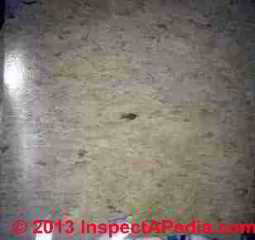 I have discussed your
inquiry with the Stationary Source Compliance Division of the United States Environmental
Protection Agency (U.S. EPA) in Washington, DC. The answer that follows is a coordinated
U.S. EPA response.
I have discussed your
inquiry with the Stationary Source Compliance Division of the United States Environmental
Protection Agency (U.S. EPA) in Washington, DC. The answer that follows is a coordinated
U.S. EPA response.
Photo at left illustrates a common pattern of Kentile vinyl asbestos flooring.
The demolition and renovation standards in the asbestos NESHAP apply only to friable asbestos materials, and the waste disposal standards for demolition and renovation operations apply only to friable asbestos waste and asbestos waste from control devices. Friable asbestos includes material containing more than one percent asbestos by weight that can be crumbled, pulverized or reduced to powder when dry by hand pressure.
However, the scope of the regulation is not limited just to asbestos containing material that is friable prior to demolition. If vinyl asbestos floor tile becomes friable during demolition or associated waste disposal, then the asbestos NESHAP applies from the point where the tile becomes friable.
Vinyl asbestos floor tile that may become friable during demolition or waste disposal should be removed prior to demolition to preclude the possibility of releasing asbestos fibers and of violating the asbestos NESHAP.
Again, the asbestos NESHAP would apply to the removed tile if it becomes friable, from the onset of friability through deposition at an acceptable waste disposal site. Since the liability extends through proper deposition, it would advisable to deposit all vinyl asbestos floor tile that can become friable at an acceptable site.
Region V has delegated its authority to implement and enforce the asbestos NESHAP to all six states in the region. By copy of this letter, I am distributing this response to the State asbestos NESHAP coordinators in Region V. If you have any questions on this matter, you may contact me at (312) 886-6793.
Sincerely yours, Bruce A. Varner NESHAP Coordinator Air Compliance Branch (5AC-26)
cc: Otto Klein
Illinois Environmental Protection Agency
EPA Regulation of handling of firable asbestos materials created during demolition
If friable asbestos materials are created in the demolition process (using imploding), the owner and operator of the demolition operation would be responsible for complying with the notification, wetting, and disposal requirements of 40 CFR Part 61, Subpart M.
The regulations define "friable asbestos" material as any material that contains more than l percent asbestos by weight that hand pressure can crumble, pulverize, or reduce to powder when dry. 40 CFR 61.141.
These regulations are designed to prevent the escape of asbestos fibers into the air. Therefore, if, at any point during a renovation or demolition operation, friable asbestos materials are created from nonfriable forms, this additional friable material becomes subject to the regulations from the time of creation. T
he owner or operator must follow the notification, wetting and disposal requirements of 40 CFR Part 61, Subpart M in regard to this newly created material.
References on Asbestos-Containing Floor Tile or other Asbestos-containing Material Removal & Disposal
- U.S. EPA, "Creation of Friable Tiles During Implosion", retrieved 9/7/2013, original source: http://www.epa.gov/oecaadix/pdf/adi-asbestos-c34.pdf, excerpted above, in a US EPA letter to Richard Miller, dated 4 December 1987, the EPA addressed friable asbestos that might be created during demolition of a building that contained vinyl asbestos floor tiles.
Significant is that the title to the letter includes the following comment
EPA believes that the demo. tech. of imploding a bldg doesnt render floor tile friable; therfore, NESHAP reg don't apply.
While the body of the letter appears to contradict that comment by including the following text:
This technique is unusual and could result in the creation of friable asbestos from the nonfriable vinyl floor tile. EPA is not in a position to determine whether friable asbestos will be created from the vinyl floor tile during the unique demolition process you plan to utilize.
However, should friable asbestos materials be created in the demolition process, the owner and operator of the demolition operation would be responsible for complying with the notification, wetting, and disposal requirements of 40 CFR Part 61, Subpart M. - The owner or operator would be subject to Federal enforcement procedures of Section 113 of the Clean Air Act, 42 U.S.C. 7413, for any violations of the Asbestos NESHAP which arise during the operation.
- U.S. EPA, "Deconstruction - Building Disassembly and Material Salvage: The Riverdale Case Study", Prepared for: US Environmental Protection Agency The Urban and Economic Development Division By: NAHB Research Center, Inc. Upper Marlboro, Maryland Assistance Agreement Number: CX 8244809 June 1997, retrieved 9/7/2013,
- US EPA Asbestos Regulation ASBESTOS EXPOSURE LIMITS (PELS) TLVs RBCs & RELs
- U.S. EPA, "Floor Tile Removal Prior to Demolition", Retrieved 9/7/2013, original source: http://www.epa.gov/oecaadix/pdf/adi-asbestos-c31.pdf
- "Occupational Exposure to Asbestos, Tremolite, Anthophyllite and Actinolite, Section 3 - III. Regulatory History, OSHA, retrieved 1/26/2013, original source: osha.gov/pls/oshaweb/o wadisp.show_ document? p_table=PREAMBLES&p_id=784, copy on file as OSHA_Regs_HistorySection_3-III.pdf
- [45] "Handling Asbestos-Containing roofing material - an update", Carl Good, NRCA Associate Executive Director, Professional Roofing, February 1992, p. 38-43
- [46] EPA Guidance for Controlling Asbestos-Containing Materials in Buildings, NIAST, National Institute on Abatement Sciences & Technology, [republishing EPA public documents] 1985 ed., Exposure Evaluation Division, Office of Toxic Substances, Office of Pesticides and Toxic Substances, U.S. Environmental Protection Agency, Washington,D.C. 20460
Government Advice on Disposal of Asbestos Containing Flooring, Roofing or Siding Materials in buildings
Asbestos in Roofing & Siding Materials
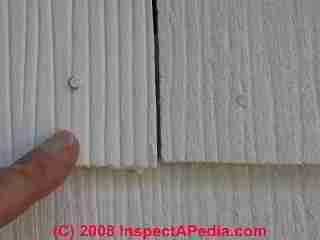
The most common siding material containing asbestos fibers was cement-asbestos shingle siding popular from about 1940 to 1970.
It is possible that other siding materials such as asphalt building siding may contain asbestos fibers as well, particularly if that material was produced during the same years that asbestos fibers appear in asphalt roof shingles (shown below)
For handling and disposal guidance concerning old roofing material, siding material, vinyl-asbestos floor tiles, asbestos pipe or boiler or furnace insulation, or other asbestos containing or suspect asbestos containing materials at a job-site, contact the US EPA, your state Department of Environmental Protection/Conservation, or your local building and health departments.
...
Continue reading at ASBESTOS MATERIAL REGULATIONS or select a topic from the closely-related articles below, or see the complete ARTICLE INDEX.
Or see these
Recommended Articles
- ADEQUATELY WET ASBESTOS GUIDANCE, EPA340/1-90-019 - asbestos-containing floor tiles are considered non-friable materials but the materials can become friable with age or by grinding, sanding, demolition, etc.
- ASBESTOS MATERIAL REGULATIONS
- ASBESTOS REMOVAL, WETTING GUIDELINES
- ASBESTOS REGULATIONS, ONTARIO, Canada
- U.K. ASBESTOS REGULATIONS
Suggested citation for this web page
ASBESTOS DISPOSAL REGULATIONS at InspectApedia.com - online encyclopedia of building & environmental inspection, testing, diagnosis, repair, & problem prevention advice.
Or see this
INDEX to RELATED ARTICLES: ARTICLE INDEX to ASBESTOS HAZARDS
Or use the SEARCH BOX found below to Ask a Question or Search InspectApedia
Ask a Question or Search InspectApedia
Questions & answers or comments about asbestos building material regulations, standards, & codes.
Try the search box just below, or if you prefer, post a question or comment in the Comments box below and we will respond promptly.
Search the InspectApedia website
Note: appearance of your Comment below may be delayed: if your comment contains an image, photograph, web link, or text that looks to the software as if it might be a web link, your posting will appear after it has been approved by a moderator. Apologies for the delay.
Only one image can be added per comment but you can post as many comments, and therefore images, as you like.
You will not receive a notification when a response to your question has been posted.
Please bookmark this page to make it easy for you to check back for our response.
IF above you see "Comment Form is loading comments..." then COMMENT BOX - countable.ca / bawkbox.com IS NOT WORKING.
In any case you are welcome to send an email directly to us at InspectApedia.com at editor@inspectApedia.com
We'll reply to you directly. Please help us help you by noting, in your email, the URL of the InspectApedia page where you wanted to comment.
Citations & References
In addition to any citations in the article above, a full list is available on request.
- [1] Celotex 1973 Celotex Acoustical Systems catalog, January 1973
- [2] Celotex Home Building Materials, 1947 catalog, lists: Cane fiber products: Celotex sheathing, Celotex insulating lath (board), Celotex interior finish, Celo-Siding, Celo-Rok Gypsum products [may contain asbestos]: Celo-Rok anchor lath, Celo-Rock wallboards, Celo-Rok plasters, and Other Products: Celotex rock wool, Celotex roofing, Celotex hard boards, Celotex Cemesta, Celotex Corporation, Chicago IL
- [3] Celotex Insulating Cane Board, product catalog
- [4] Celotex Building Insulating Materials, 1948 Catalog, listing: Cemesto insulation, Cemesto roof decks, Cemesto exterior wall coverings, Cemesto interior wall coverings [we believe the Cemesto lines refer to cement-asbestos products - ed. ]
- [5] Celotex Sound Conditioning, 1948 Catalog, including perforated asbestos board sheets
- Celotex ceiling products division was purchased by Ceiling Products & Gypsum Wallboard (BPB) of the U.K. beginning in 1999
- Celotex roofing products division was purchased by Certainteed Corporation (Valley Forge PA) beginning in 1999
- [6] Certainteed Ceilings, Adagio fiberglass/mineral fiber composite acoustical ceiling product MSDS, web search 11/22/2011, original source: certainteed.com/resources/Adagio_MSDS_2010.pdf
- [7] "Board of Education for the School District of the City of Detroit v. Celotex, et al., Circuit Court of Wayne County, Michigan, No. 84-429634-ND"
- [8] Armstrong Corporation, web search 6/22/12, original source: http://www.armstrong.rs/commclgeu/eu1/uk/rs/FAQ_other.html, [Copy on file as Armstrong_Ceil_Asbestos.pdf]
- [9] Lipsitz & Ponterio, LLC, "Carpenters and Mesothelioma", Lipsitz & Ponterio, LLC, 135 Delaware Ave, 5th Floor, Buffalo, NY 14202-2415 (716) 849-0701. Web search 6/22/12, original source: http://www.mesotheliomacarpenter.com/carpenters-asbestos-exposure/ceiling-tile/ [Copy on file as LiIpsitz_Asbestos.pdf]
- [10] INACHI forum discussion about asbestos ceiling tiles, web search 6/22/12, original source: http://www.nachi.org/forum/f18/asbestos-ceiling-tiles-14709/ [Copy on file as Inach_Ceil_Asbestos.pdf]
- [11] Celotex [UK] History, Celotex Insulation Specialists, web search 6/30/12, original source: http://www.celotex.co.uk/celotex-history [Copy on file as Celotex_History_UK.pdf ]
- [12] Wikipedia Web: https://www.wikipedia.org/ provided background information about some topics discussed at this website provided this citation is also found in the same article along with a " retrieved on" date. NOTE: because Wikipedia entries are fluid and can be amended in real time, we cite the retrieval date of Wikipedia citations and we do not assert that the information found there is necessarily authoritative. Web search 6/30/12: "Ceiling Tiles"
- [13] Brian Greer, "History of Tin Ceilings", Brian Greer's Tin Ceilings, web search 6/30/12, original source: http://www.tinceiling.com/company/historytin.php
- [14] Armstrong Corporation, "Corporate History: a Historical Summary", web search 6/30/12, original source: https://www.armstrongflooring.com/corporate/corporate-history.html
- [15] "Ceilings Pressed in Time", Old House Journal, web search 6/30/12, original source: http://www.oldhousejournal.com/ceillings_pressed_in_time/magazine/1070
- [16] Steven Mlynarek, Morton Corn, Charles Blake, "Asbestos Exposure of Building Maintenance Personnel", Regulatory Toxicology and Pharmacology, 23, 213–224 (1996) ARTICLE NO. 0045, http://library.certh.gr/libfiles/PDF/GEN-PAPYR-4810-ASBESTOS-by-MLYNAREK
-in-RTAP-VOL-23-ISS-3-PP-213-224-Y-1996.pdf - [17] National Institute of Occupational Safety and Health (NIOSH) (1989). In NIOSH Manual of Analytical Methods (P. M. Eller, Ed.), Method 7400. NIOSH, Washington, DC.
- [18] U.S. Environmental Protection Agency (USEPA—Green Book) (1990). In Managing Asbestos in Place: A Building Owners Guide to Operations and Maintenance Programs for Asbestos-Containing
- [19] U.S. Department of Labor, Occupational Safety and Health Administration (USDOL) (1994). In Occupational Exposure to Asbestos: Final Rule, FR Vol. 59, No. 153:40964–41162. Materials, Report 2OT-2003. USEPA, Washington, DC.
- [20] U.S. Department of Labor, Occupational Safety and Health Administration
(USDOL) (1986). In Occupational Exposure to Asbestos: Tremolite, Anthophyllite, and Actinolite: Final Rule, FR Vol. 51, No. 119:22631–22644. - [21] U.S. Environmental Protection Agency (USEPA) (1990). In Environmental Asbestos Assessment Manual, Superfund Method for the Determination of Asbestos in Ambient Air, Part 2, Technical Background Document, Report EPA/540/2-90/005 b. USEPA, Washington, DC
- [22] Ceiling - Frequently Asked Questions, Armstrong Corporation, web search 6/30/12, original source: https://www.armstrongflooring.com/resclgam/na/ceilings/en/us/article17697.html
- [23] BPB America Inc., 5301 West Cypress St., Suite 300, Tampa, FL 33607, Tel: 866-427-2872 E-mail: crc@bpb-na.com Web: www.bpb-na.com. Acoustic ceiling tile & accessories.
- [24] Affa Tile Company No. 1116/8, Poonamalee High Road, Opposite Hotel Shan Royal, Koyambedu Chennai, Tamil Nadu - 600 107, India, E-Mail: affatiles@gmail.com website: http://www.affatiles.com Tel:044-24757498, 044 - 24757497
- [25] Made-in-China.com, online sevice to connect buyers with product suppliers in China, web search 6/30/12
- [26] "Directive 2003/18/EC of the European Parliament and of the Council of 27 March 2003 amending Council Directive 83/477/EEC on the protection of workers from the risks related to exposure to asbestos at work". Publications Office of the European Union. 27 March 2003 Web search 6/30/12, original source: http://eur-lex.europa.eu/LexUriServ/LexUriServ.do?uri=CELEX:32003L0018:EN:NOT,
- [27] H. M. Murray, testimony before the Departmental Committee on Compensation for Industrial Diseases "Minutes of Evidence, Appendices and Index", 1907. p. 127
- [28] D. Auribault, "Note sur l'Hygiène et la Sécurité des Ouvriers dans les Filatures et Tissages d'Amianté (On hygiene and security of the workers in the spinning and weaving of asbestos)" in Le Bulletin de l'Inspection du Travail, 1906, pp 120–132.
- [29] Wikipedia entry on Asbestos and various citations from that article, web search 6/30/12, original source: en.wikipedia.org "Asbestos"
- [30] "Handling Asbestos-Containing roofing material - an update", Carl Good, NRCA Associate Executive Director, Professional Roofing, February 1992, p. 38-43
- [31] EPA Guidance for Controlling Asbestos-Containing Materials in Buildings, NIAST, National Institute on Abatement Sciences & Technology, [republishing EPA public documents] 1985 ed., Exposure Evaluation Division, Office of Toxic Substances, Office of Pesticides and Toxic Substances, U.S. Environmental Protection Agency, Washington,D.C. 20460
- EPA Asbestos Materials Bans: Clarification, May 18, 1999, U.S. Environmental Protection Agency, web search 01/20/2011, original source http://www.epa.gov/asbestos/pubs/asbbans2.pdf
- [32] EPA Asbestos Materials Bans-1989: 1989 (OBSOLETE)
On July 12, 1989, EPA issued a final rule banning most asbestos-containing products. In 1991, this regulation was overturned by the Fifth Circuit Court of Appeals in New Orleans. As a result of the Court's decision, the following specific asbestos-containing products remain banned: flooring felt, rollboard, and corrugated, commercial, or specialty paper. In addition, the regulation continues to ban the use of asbestos in products that have not historically contained asbestos, otherwise referred to as "new uses" of asbestos.
For more [current] information read EPA Asbestos Materials Ban (ABPO Rule): Clarification (PDF)(this is a 1999 document, 3 pp., 10 K shown at the top of this page) - May 1999, web search 01/20/2011, original source: http://www.epa.gov/asbestos/pubs/asbbans2.pdfWeb Search 01/20/2011, original source: http://www.epa.gov/asbestos/pubs/ban.html - quoting:
Below are four relevant Federal Register notices [ concerning asbestos manufacture, use, and bans in the U.S.] :- [33] Asbestos: Manufacture, Importation, Processing, and Distribution in Commerce Prohibitions; Final Rule(54 FR 29460, July 12, 1989) (FRL-3476-2) (PDF) (LARGE FILE 55 pp, 8.2MB) - web search 01/20/2011, original source http://www.epa.gov/asbestos/pubs/frl-3476-2.pdf
- [34] Asbestos; Manufacture, Importation, Processing and Distribution Prohibitions; Effect of Court Decision; Continuing Restrictions on Certain Asbestos-Containing Products (57 FR 11364, April 2, 1992) (FRL-4044-2) (PDF) (2 pp, 250K) web search 01/20/2011, original source http://www.epa.gov/fedrgstr/EPA-TOX/pre1994/4044-2.pdf
- [35] Asbestos; Manufacture, Importation, Processing and Distribution Prohibitions; Continuing Restrictions on Certain Asbestos-Containing Products (58 FR 58964, November 5, 1993) (FRL-4635-7) (PDF) (5 pp., 588K) web search 01/20/2011, original source http://www.epa.gov/fedrgstr/EPA-TOX/pre1994/4635-7.pdf
- [36] Technical Amendment in Response to Court Decision on Asbestos; Manufacture, Importation, Processing and Distribution Prohibitions; Technical Amendment (59 FR 33208, June 28, 1994) (FRL-4776-7) (PDF) (4 pp., 350K) web search 01/20/2011, original source http://www.epa.gov/fedrgstr/EPA-TOX/pre1994/4776-7.pdf
- Asbestos Laws and Regulations, U.S. EPA
Laws and Regulations
[37] TSCA (15 U.S.C. § 2601 et seq.)
Title 1 - Control of Toxic Substances - § 2605. Regulation of hazardous chemical substances and mixtures, web search 01/2/2011, original source: http://www.gpo.gov/fdsys/pkg/USCODE-
2009-title15/html/USCODE-2009-title15-chap53-subchapI-sec2605.htm
[38] Title 2 - Asbestos Hazard Emergency Response, web search 01/2/2011, original source: http://www.gpo.gov/fdsys/pkg/USCODE-2009-title15
/html/USCODE-2009-title15-chap53-subchapII.htm
[39] Code of Federal Regulations and Federal Register Notices
Code of Federal Regulations
[40] 40 CFR Part 763 - Asbestos (PDF) (96 pp, 588K, about PDF), web search 01/2/2011, original source: http://www.epa.gov/asbestos/pubs/2003pt763.pdf
Subpart E - Asbestos-Containing Materials in Schools
Subpart G - Asbestos Worker Protection
Subpart I - Prohibition of the Manufacture, Importation, Processing and Distribution in Commerce of Certain Asbestos-Containing Products; Labeling Requirements
[41] 40 CFR Part 61, Subpart M - National Emission Standards for Asbestos (PDF) (51 pp, 353K, about PDF) web search 01/2/2011, original source: http://www.epa.gov/asbestos/pubs/40cfr61subpartm.pdf
[42] Federal Register
Federal Register Notices - The Government Printing Office maintains a searchable database of all Federal Register (FR) Notices.
[43] The U.S. EPA also maintains a searchable listing of Federal Register Notices published by EPA. - [44] Asbestos products and their history and use in various building materials such as asphalt and vinyl flooring includes discussion which draws on Asbestos, Its Industrial Applications, D.V. Rosato, engineering consultant, Newton, MA, Reinhold Publishing, 1959 Library of Congress Catalog Card No.: 59-12535 (out of print).
- [47] Copy on file as - /hazmat/Asbestos_in_Your_Home_US_EPA.pdf - Asbestos in Your Home - U.S. EPA, Exposure Evaluation Division, Office of Toxic Substances, Office of Pesticides and Toxic Substances, U.S. Environmental Protection Agency, Washington,D.C. 20460
- [48] NRCA Roofing and Waterproofing Manual, 4th Ed., available from the National Roofing Contractors' Association.
- [49] "Tips for working with fiber-cement roofing products", Thomas L. Smith, AIA, RRC, Professional Roofing, September 1996
- [50] "About Asbestos Cement Roof Shingles", Ann Johnson, at ehow.com, a nice article about the history of this material - November 2008.
- [51] Thanks to reader Tom Sukeforth, Asbestos & Lead Project Manager, Department of Facilities Management, University of Maine for updating our information on the current permissible exposure limits (PELS) for asbestos fibers, and for the discussion of PACM. 07/29/2010.
- [52] Presumed Asbestos-Containing Material (PACM) vs. Suspect Asbestos-Containing Material, Michael Kindley, CIHWorkplace Hygiene website, via web search 07/29/2010, http://www.workplace-hygiene.com/articles/PACM-v-Susp.html
- [53] Asbestos regulations for Ontario are published under the Occupational Health and Safety Act and are in Ontario Regulation 278/05 Web search 11/4/2010, original source: http://www.e-laws.gov.on.ca/html/regs/english/elaws_regs_050278_e.htm
- [54] Joseph H. Guth, PhD, CIH, President of Scientific and Forensic Services Inc., Delray Beach FL. kindly contributed technical editing, correcting our erroneous report of the date at which OSHA began attending asbestos hazards in the U.S.
- [56] "Reflections on OSHA's History", U.S. Department of Labor Occupational Safety and Health Administration January 2009 OSHA 3360, retrieved 1/26/2013, original source http://www.osha.gov/history/OSHA_HISTORY_3360s.pdf copy on file as OSHA_HISTORY_3360s.pdf
- In addition to citations & references found in this article, see the research citations given at the end of the related articles found at our suggested
CONTINUE READING or RECOMMENDED ARTICLES.
- Carson, Dunlop & Associates Ltd., 120 Carlton Street Suite 407, Toronto ON M5A 4K2. Tel: (416) 964-9415 1-800-268-7070 Email: info@carsondunlop.com. Alan Carson is a past president of ASHI, the American Society of Home Inspectors.
Thanks to Alan Carson and Bob Dunlop, for permission for InspectAPedia to use text excerpts from The HOME REFERENCE BOOK - the Encyclopedia of Homes and to use illustrations from The ILLUSTRATED HOME .
Carson Dunlop Associates provides extensive home inspection education and report writing material. In gratitude we provide links to tsome Carson Dunlop Associates products and services.



